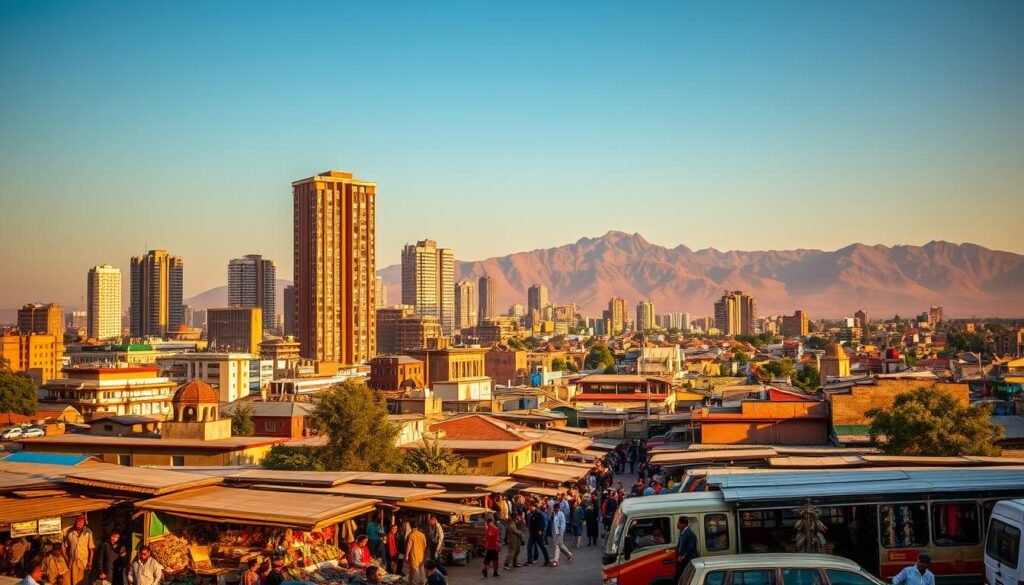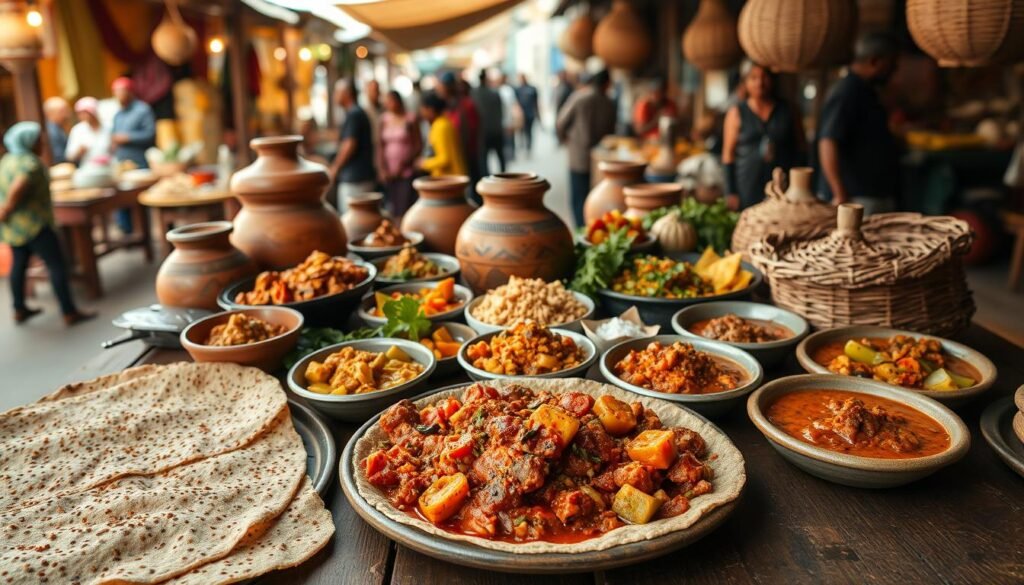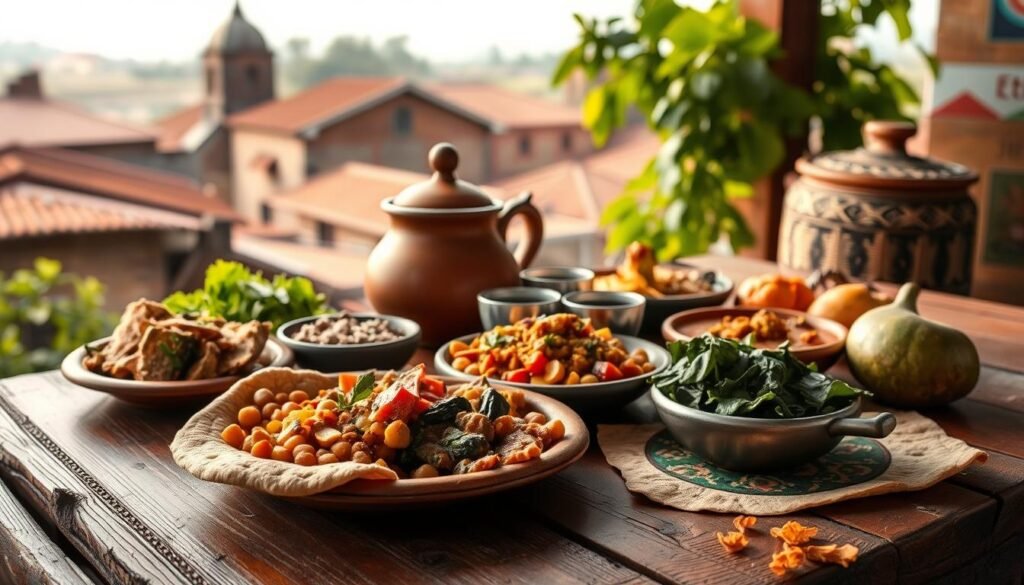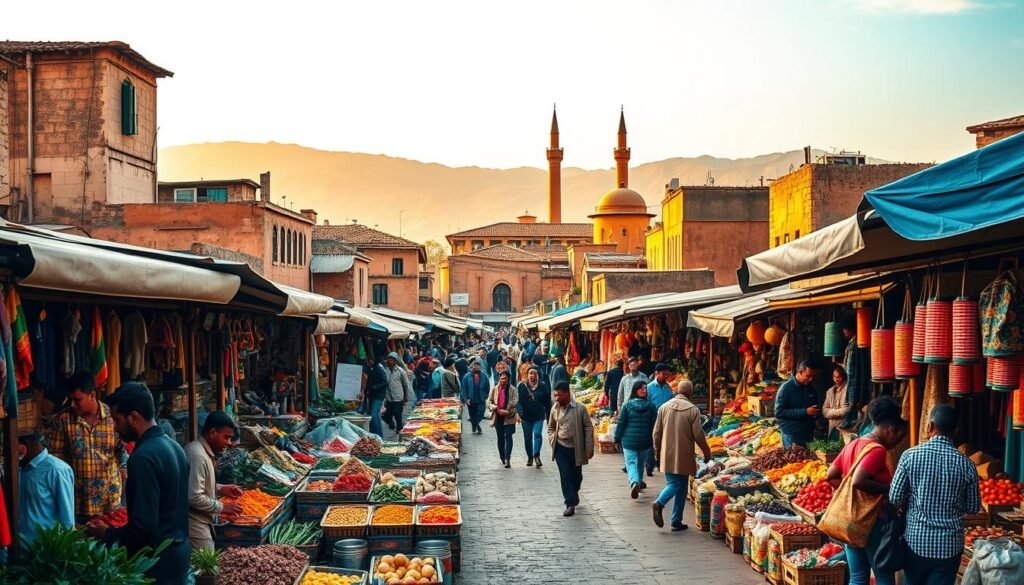
Ethiopia’s capital city, Addis Ababa, is a lively place. It mixes old traditions with new ways. Known as ‘New Flower’ in Amharic, it’s full of culture and history.
The weather is nice, and the views are amazing. Addis Ababa is a special spot for visitors. You can taste the rich Ethiopian food and see its historical sites.
Addis Ababa is a mix of old and new. It’s fun to explore. From its traditional cuisine to its modern sights, there’s something for everyone.
Key Takeaways
- Experience the rich cultural heritage of Ethiopia in Addis Ababa.
- Enjoy the city’s pleasant climate and natural surroundings.
- Discover the unique blend of traditional and modern attractions.
- Savor the delicious and diverse Ethiopian cuisine.
- Explore the historical landmarks and significance of the city.
Discovering Ethiopia’s Vibrant Capital
Addis Ababa, the capital of Ethiopia, is a lively city. It mixes old traditions with modern life. The city’s nice weather makes it a great spot for visitors and business people.

The Heart of Ethiopian Culture and Cuisine
Addis Ababa is the center of Ethiopian culture and cuisine. It has many traditional dishes and cultural activities. The food here uses local ingredients and old cooking ways.
- Experience the rich flavors of Ethiopian cuisine
- Explore local markets and try traditional foods
- Visit cultural centers to learn about Ethiopian heritage
A Brief History of Addis Ababa
Founded by Emperor Menelik II in 1886, Addis Ababa has a deep history. This history is seen in its historical sites and cultural spots. The city’s growth shows its strength and ability to change.
The city keeps its history alive through museums and old buildings. It’s a must-see for those who love history.
Understanding Ethiopian Cuisine: A Culinary Overview
Ethiopian cuisine is all about its staple foods, spices, and how people eat together. It’s known for its unique flavors and spices. Injera, a sourdough flatbread, is a key part of every meal. It’s not just food; it’s a way to connect with others.
The Significance of Injera in Ethiopian Meals
Injera is the base of Ethiopian meals. It’s made from teff flour and is more than just food. It’s a cultural symbol. Injera is used to pick up stews and salads, making meals interactive.
Injera’s Role in Ethiopian Culture
- Central to every meal
- Used as a utensil to eat other dishes
- A symbol of community and sharing
Spices and Flavors That Define Ethiopian Food
Ethiopian food is famous for its complex spice blends. Berbere, a mix of chili peppers, garlic, ginger, and spices, is key. Spices add flavor and show the country’s rich culture and history.

Traditional Eating Customs and Etiquette
Eating in Ethiopia is a group activity. Food is on a large injera, and everyone shares. It’s proper to eat with your right hand, using injera to pick up food.
| Eating Custom | Description |
|---|---|
| Communal Eating | Food is shared from a common plate. |
| Eating with Hands | Using the right hand to pick up food with injera. |
| Respect for Elders | Elders are served first as a sign of respect. |
Ethiopian cuisine shows the country’s rich culture. Knowing its importance, flavors, and customs helps us appreciate this unique food tradition.
Addis Ababa Famous Food and Famous Places You Can’t Miss
Addis Ababa is a city that offers an unforgettable experience. Its food scene is rich with flavors and spices. The landmarks show the city’s deep history and cultural heritage.
Signature Dishes That Define the City
Addis Ababa’s food reflects Ethiopia’s diverse culture. Doro Wat, a spicy chicken stew, is a favorite at special events. Tibs, sautéed meat, is often served with injera, a sourdough flatbread.
The city also has great vegetarian dishes. Misir Wot, a spicy red lentil stew, and Shiro, a chickpea flour stew, are popular. These dishes highlight the variety and richness of Ethiopian cuisine.
| Dish | Description |
|---|---|
| Doro Wat | Spicy chicken stew |
| Tibs | Sautéed meat |
| Misir Wot | Spicy red lentil stew |
Iconic Landmarks That Represent Addis Ababa
Addis Ababa boasts many landmarks that show its rich history. The National Museum of Ethiopia is a key attraction, featuring the famous “Lucy” fossil. The Holy Trinity Cathedral is also significant, as it’s where Emperor Haile Selassie and his wife are buried.
Local Favorites vs. Tourist Attractions
While tourists love the National Museum and Holy Trinity Cathedral, locals have their own spots. The Merkato Market is a lively marketplace that shows the daily life of Addis Ababa’s people.
Knowing both local and tourist spots offers a richer experience. It lets visitors truly appreciate Addis Ababa’s culture and history.
Must-Try Traditional Dishes in Addis Ababa
Addis Ababa’s food scene shows off Ethiopia’s rich culture. You’ll find many traditional dishes to try. Ethiopian food is special because of its spices, flavors, and textures. It’s often eaten with Injera, a sourdough flatbread.

Doro Wat: Ethiopia’s National Dish
Doro Wat is a spicy chicken stew loved by all. It’s made with onions, garlic, ginger, and berbere spices. This dish is perfect for special events.
Kitfo and Tibs: Meat Delicacies
Meat fans will love Kitfo and Tibs. Kitfo is raw minced beef with spices. Tibs is sautéed meat with onions and peppers. Both are great with Injera or bread.
Vegetarian Specialties: Beyainatu and Shiro
Ethiopian food has many vegetarian choices. Beyainatu is a vegetable platter. Shiro is a stew from chickpeas or lentils. These dishes are tasty and show the variety of Ethiopian food.
Ethiopian Coffee Ceremony Experience
Don’t miss the Ethiopian coffee ceremony in Addis Ababa. It’s a ritual of roasting, grinding, and brewing coffee in a jebena clay pot. It’s a sign of hospitality and friendship.
Unique Breakfast Options: Genfo and Chechebsa
Try Genfo, a barley flour porridge, or Chechebsa, a sourdough pancake. These breakfasts are tasty and show local cooking habits.
Addis Ababa’s food scene is rich and varied. From Doro Wat to breakfast dishes like Genfo and Chechebsa, there’s something for everyone.
- Doro Wat: Spicy chicken stew
- Kitfo: Minced raw beef
- Tibs: Sautéed meat
- Beyainatu: Mixed vegetable platter
- Shiro: Chickpea or lentil stew
- Genfo: Barley flour porridge
- Chechebsa: Sourdough pancake-like dish
Top Restaurants and Food Markets in Addis Ababa
Exploring Addis Ababa’s top restaurants and food markets is a journey into Ethiopian cuisine’s heart. The city has a wide range of dining options. You can find everything from fine dining to street food and cultural restaurants with traditional entertainment.
Fine Dining Experiences
Addis Ababa boasts many fine dining spots that offer a modern twist on traditional Ethiopian cuisine. Places like YOD Abyssinia Cultural Restaurant and Zem Zem Restaurant provide a luxurious dining experience. Their menus showcase the rich flavors and spices of Ethiopian cooking.
These upscale restaurants often feature live traditional music and dance. This adds to the cultural vibe. They are favorites among locals and tourists seeking a premium dining experience.
Authentic Local Eateries
For a real taste of Ethiopian cuisine, visit local eateries. These family-run spots offer a cozy setting and genuine Ethiopian dishes. Kitfo and Doro Wat are popular dishes here.
Merkato: Africa’s Largest Open-Air Market
A trip to Merkato, one of Africa’s largest open-air markets, is a must. Merkato is more than a shopping spot; it’s a place to dive into local food culture. You can try a variety of street foods and local treats, from injera to traditional snacks.

Street Food Adventures
Street food is a big part of Addis Ababa’s food scene. You’ll find everything from grilled meats to spicy stews. Exploring street food stalls and markets is a great way to enjoy local flavors at low prices.
Cultural Restaurants with Traditional Entertainment
Cultural restaurants in Addis Ababa offer more than food; they provide a cultural dive. Places like Abyssinia Cultural Restaurant feature traditional Ethiopian music and dance. This lets diners enjoy the local culture while they eat.
These cultural restaurants are a key way to experience Ethiopia’s rich cultural heritage. They are a must-visit for anyone wanting to understand the local way of life.
Historical Landmarks and Museums
Addis Ababa’s historical sites and museums show Ethiopia’s rich culture and history. The city is full of landmarks that tell its story. These sites highlight the city’s past and its cultural and religious importance.
National Museum of Ethiopia and Lucy
The National Museum of Ethiopia is a key cultural spot. It houses “Lucy,” a 3.2 million-year-old hominid. Lucy is a major find in human history, giving us insights into our evolution.
The museum has artifacts from different times in Ethiopian history. It gives a full view of the country’s culture and history.
Holy Trinity Cathedral
Holy Trinity Cathedral is a major religious site in Addis Ababa. It’s known for its stunning architecture and historical value. It’s where Emperor Haile Selassie and his wife, Empress Menen Asfaw, are buried.
The cathedral is more than a place of worship. It’s a symbol of Ethiopia’s rich religious history. Visitors can see its beautiful stained-glass windows and detailed stone carvings.
Ethnological Museum at Addis Ababa University
The Ethnological Museum at Addis Ababa University is a key cultural spot. It shows the diverse cultures and traditions of Ethiopia’s ethnic groups.
- Exhibits include traditional clothing, musical instruments, and household items.
- The museum gives insight into the daily lives and customs of Ethiopia’s people.
Red Terror Martyrs Memorial Museum
The Red Terror Martyrs Memorial Museum is a reminder of Ethiopia’s past. It honors the victims of the Red Terror regime.
The museum’s exhibits tell personal stories, show photographs, and display artifacts. They highlight the regime’s brutality and the victims’ resilience.
St. George’s Cathedral and Menelik’s Palace
St. George’s Cathedral is a famous landmark in Addis Ababa. It’s known for its unique octagonal shape and historical significance. Nearby, Menelik’s Palace, the former imperial palace, is another important historical site. It gives a look into the country’s royal past.
These landmarks are not just historical. They are cultural icons of Ethiopia. They show the country’s rich heritage and its journey through time.
Natural Attractions and Outdoor Experiences
Addis Ababa is more than just a city. It’s surrounded by mountains, forests, lakes, and green spaces. These natural wonders offer many chances for outdoor fun and discovery.
Entoto Mountain and Park
Entoto Mountain is a favorite for hikers. It gives stunning views of Addis Ababa. It’s also a cultural site with historic churches and monasteries.
Visitors can hike, picnic, and explore the local plants and animals. It’s a great place for nature lovers and history buffs.
Menagesha National Forest
Menagesha National Forest is a peaceful spot near Addis Ababa. It’s full of plants and animals. It’s perfect for hiking, bird watching, and enjoying nature.
Lake Hora and Surrounding Areas
Lake Hora is a beautiful spot about an hour from Addis Ababa. It’s famous for its birdlife, including pelicans. Visitors can enjoy the views, take a boat ride, or relax in the beauty around.
Urban Parks and Green Spaces
Addis Ababa has many parks and green spaces. They offer a calm break from the city. These areas are great for picnics, walks, or just enjoying the greenery.
As “Addis Ababa’s natural attractions offer a unique blend of outdoor adventure and cultural exploration”, there’s something for everyone. Whether hiking, exploring forests, or enjoying urban parks, Addis Ababa has it all.
Exploring Addis Ababa’s Vibrant Neighborhoods
The city’s neighborhoods are full of life, showing both old traditions and new ways. Each area in Addis Ababa has its own special feel. This makes the city a great place to explore.
Piassa: The Old Quarter
Piassa is rich in history and a key spot for learning about the city’s past. It’s filled with landmarks and gives a peek into the lives of the city’s first people.
Bole: Modern Addis
Bole shows the modern side of Addis Ababa. It’s lively with shops, restaurants, and places to have fun. It shows the city’s growth and progress.
Kazanchis and the Diplomatic Area
Kazanchis is known for its many embassies and international groups. It’s a center of global activity. It gives a special view of the city’s role in the world.
Mercato District: Shopping and Local Life
Mercato is a huge outdoor market in Africa. It’s a shopper’s dream. It also lets you see into the local culture and daily life of Addis Ababa’s people.
Here’s a quick look at what each neighborhood offers:
| Neighborhood | Main Attractions | Experience |
|---|---|---|
| Piassa | Historical landmarks | Traditional |
| Bole | Shopping centers, restaurants | Modern |
| Kazanchis | Embassies, international organizations | Diplomatic |
| Mercato | Open-air market, local goods | Local culture |
Visiting these areas gives a full picture of Addis Ababa’s rich culture, history, and modern life.
Essential Tips for Your Addis Ababa Adventure
Visiting Addis Ababa, the vibrant Ethiopian capital, can be a rich and rewarding experience. To make the most of your trip, it’s essential to be mindful of the local culture and cuisine. When exploring the city’s numerous tourist attractions, dress modestly and respect local customs to avoid unintended offense.
Navigating Addis Ababa can be challenging, but with some preparation, you can enjoy a smooth journey. Be prepared for variable traffic conditions and consider hiring a local guide to help you navigate the city’s hidden gems. When trying the local cuisine, don’t hesitate to ask for recommendations from locals, and be adventurous in trying new dishes.
From the historic landmarks to the bustling markets, Addis Ababa offers a unique blend of traditional and modern experiences. By being respectful of the local way of life and embracing the city’s culture and cuisine, you’ll be able to fully appreciate the beauty and charm of this fascinating Ethiopian capital.